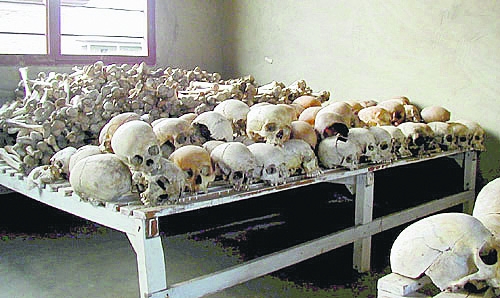A Different View
100 days when the world sank to somewhere beyond evil

There are moments in history when you wonder if all humanity is lost, and twenty years ago this week saw the start of that descent into sheer barbarism as over 800,000 people were butchered to death in Rwanda over 100 days while the world stood idly by.
And if I live to be 100, I know that I will never see a more abhorrent sight than that of hundreds of calcified skulls and skeletons piled high on wooden pallets in the rooms of a school that never opened – and now never will.
The Murambi Technical School, now known as the Murambi Genocide Memorial Centre, sits in the quiet hills, deep in the countryside of southern Rwanda.
Like most of the world, I’d never heard of it until I visited there as part of a Trocaire delegation in 2004 – a decade after the genocide.
We were there to report, and they were there to see the impact of Ireland’s development funding.
We met Josienne, who featured on the Trocaire box that year and who is now a 22 year old university student, getting ready to graduate in accountancy thanks to support from Ireland.
So we saw the positives for sure, and so much about Rwanda is breathtaking – it’s a beautiful country (the call it the land of a thousand hills) with arable, fertile soil; it is more developed that most of its nearest neighbours, and its people couldn’t be friendlier.
But there was still a palpable sense of unease in the air – a tension that wasn’t imagined.
And when you made even the smallest mention of the 1994 genocide, lips tightened and heads turned away.
The miracle is how the country survived at all, because words cannot explain what occurred … but in the simplest of terms, the plane carrying the Rwandan President Juvénal Habyarimana was shot from the skies and six days later – egged on by radio stations and politicians – the Hutus attacked their neighbours (and sometimes their own families) because they believed the Tutsis were ‘cockroaches’ who had to die.
These were not two tribes from different ethnic backgrounds – they were simply the respective inhabitants of pre-colonial kingdoms before the arrival of the Belgians.
Generally, the Tutsis were richer, but intermarriage was commonplace and there was little discernible difference between one and the other. There were historical tensions, but it might be described as little more than an exaggerated version of inter-county rivalry.
Nothing could ever justify these depths of depravity anyway, but even now it is hard to see how such a bloodbath could ensue in such a short space of time.
When the killings started, Tutsis in the region tried to hide at a local church, but the local bishop and the town’s mayor lured them into a trap by sending them to the technical school, insisting that French peacekeeping troops would protect them there.
This was a brand new school waiting to be opened – but events over those darkest of days ensured its role now would change forever.
On April 16, 1994, some 65,000 Tutsis ran to the school. After the victims were told to gather there, water was cut off and no food was available, so that the people were too weak to resist.
After defending themselves for a few days using stones, the Tutsi were overrun on April 21. The French soldiers disappeared and the school was attacked by militiamen from the Interhamwe, a paramilitary force that was the epitome of evil.
Some 45,000 Tutsi were murdered at the school, and almost all of those who managed to escape were killed the next day when they tried to hide in a nearby church. And the history shows that the Catholic Church – or some of its priests and bishops – were as culpable, if not complicit, in this genocide as any.
The French brought in heavy equipment to dig several pits for thousands of bodies, and laid a volleyball court over them to hide what happened.
But over ground and in every single classroom, there are thousands of calcified bodies – so many of them children and infants – sometimes in rows, often just bones piled on top of each other.
You look at the little skulls of the children and you see them cracked like an egg. A man who acts as a sort of tour guide tells you that was because they caught these children, tied their hands behind their backs…..and threw them head first at the wall, like a hooker throwing a rugby ball into a line-out.
They repeated this unspeakable evil as many times as it took to kill them …. as their parents and siblings watched on, waiting their turn to die.
The lucky ones were shot to death, because the pain of waiting must have been worse. And now twenty years on, you still wonder how man was capable of doing this to fellow man.
This was just one location – the Hutus, armed with pitch forks, knives and machetes, descended into village, murdered everyone in it with impunity; they gang-raped the women, they set up road blocks and, high on drugs, they killed with gay abandon.
The truth is that – twenty years ago – most of the world wasn’t even aware of this hell on earth being endured by the minority Tutsi population in that most beautiful of African countries – and those who should have known simply turned their backs.
Because while Rwanda is rich in agriculture, it isn’t rich in oil – so there was no reason for the Americans to worry too much about it.
The Belgians, Rwanda’s old colonial masters, probably didn’t have the resources to do much about it, but even if they could, they weren’t hanging around to find out.
The United Nations had a presence, but it was hopelessly inadequate to enforce any semblance of law and order – the best they could do was evacuate the non-nationals and effectively leave the Tutsis to the hands of the Hutus.
The genocide trials began in 1996 and ten years later the jails were still wedged with prisoners.
In-mates in Rwandan jails are dressed head to toe in pink – and this too was one of the most incongruous sights you could ever see … hundreds of mass killers doing a tribal dance in shocking pink.
Some of them have now returned to their own villages, next door again to the survivors and relatives of those they killed.
You cannot begin to understand how society can function in such circumstances, but some of it is down to the Gacaca courts, a system (now closed) where the village elders gathered in the shade of a tree and held court of a sort.
This was where those who played a part in the killings admitted their role and gave up the names of those who led the attacks; the idea was to get to the ringleaders, who would then face the UN’s International War Tribunal.
It was also – unbelievably – a chance for some to forgive their family’s killers … a gesture so profound that it is difficult to fathom.
And it is those people – twenty years later – that I remember this week; the people who found forgiveness in their hearts for those who sank lower than humanity ever thought possible.
Connacht Tribune
If you don’t know who you are, the door staff have no chance

A Different View with Dave O’Connell
The only time in your life that you should ever utter the words: “Do you know who I am?” are if you’ve just had a bang on the head or you are unfortunately suffering from dementia.
Because, otherwise, the phrase ‘do you know who I am’ only serves to make things a whole lot worse.
Normally, the phrase is unleashed towards late night door staff on a wave of alcohol – and never once in the history of time has it produced the result the utterer had intended.
The doorman may well know who you are which is often the very reason you’re not getting into the place in the first instance – or if he doesn’t know who you are, he won’t be unduly influenced when he does, unless you’re a famous movie star or his long-lost cousin.
‘Do you know where I am?’ might often be closer to the phrase you’re looking for, because that would serve you well when you’re looking for a taxi.
‘Do you know who I am?’ is a threatening phrase that in truth wouldn’t frighten the cat. But if you’re anxious to dig the hole a few shovels deeper, you should follow up with ‘I’d like to speak to your manager.’
Managers can be elusive at the best of times, but they’re normally rarer than hen’s teeth when it comes to the small hours of the morning – and even if they’re there, they are most likely watching proceedings on CCTV…just so they know who you are, in case you yourself can’t remember.
‘I’d like to speak to your manager’ suggests that you and he or she are from the one social sphere which is several strata north of the one occupied by door staff.
For more, read this week’s Connacht Tribune.
Connacht Tribune Digital Edition App
Download the Connacht Tribune Digital Edition App to access to Galway’s best-selling newspaper.
Click HERE to download it for iPhone and iPad from Apple’s App Store, or HERE to get the Android Version from Google Play.
Or purchase the Digital Edition for PC, Mac or Laptop from Pagesuite HERE.
Get the Connacht Tribune Live app
The Connacht Tribune Live app is the home of everything that is happening in Galway City and county. It’s completely FREE and features all the latest news, sport and information on what’s on in your area. Click HERE to download it for iPhone and iPad from Apple’s App Store, or HERE to get the Android Version from Google Play.
Connacht Tribune
Eurovision is just a giant party that could never cause offence

A Different View with Dave O’Connell
As it turned out, we were much closer to a Eurovision win than we could ever have imagined – not Ireland, of course, because we’ve now mastered the art of just sending cannon fodder to be blown out in the semi-final.
No, this was just two of us – myself and our eldest – who were lucky enough to be at Anfield for the Reds’ recent win over Brentford, where positioned in the seat right in front of us were four happy lads from Finland.
One of them, we now know, was Käärijä, the singer of the catchiest song at Eurovision, Cha Cha Cha.
But just a week before 7,000 people sung his catchphrase at the Eurovision Arena, he and two his mates – accompanied by an older bloke who had to be either his dad or from the national broadcaster – sat anonymously in the same corner of the lower level of Anfield’s Main Stand.
He was utterly unknown to us as well of course, and the only thing that saw him stand out was his green nail varnish. Live and let live, of course, but it still ensures that you make an impression even if it looks like you were just very late for St Patrick’s Day.
Käärijä may well be Liverpool’s greatest Scandinavian fan, although the bar for that is set fairly high, given that they invade the city in greater numbers every two weeks than the Vikings did just once during the first millennium.
Equally, he may not be a football fan at all – although, as the rest of the week proved, he sure loves a crowd.
Positioned as we were in the corner of the Main Stand, the next section to us, around the corner in the Anfield Road Stand – currently adding a top layer – was occupied by the visiting Brentford supporters.
For more, read this week’s Connacht Tribune.
Connacht Tribune Digital Edition App
Download the Connacht Tribune Digital Edition App to access to Galway’s best-selling newspaper.
Click HERE to download it for iPhone and iPad from Apple’s App Store, or HERE to get the Android Version from Google Play.
Or purchase the Digital Edition for PC, Mac or Laptop from Pagesuite HERE.
Get the Connacht Tribune Live app
The Connacht Tribune Live app is the home of everything that is happening in Galway City and county. It’s completely FREE and features all the latest news, sport and information on what’s on in your area. Click HERE to download it for iPhone and iPad from Apple’s App Store, or HERE to get the Android Version from Google Play.
Connacht Tribune
Tapping is contactless – but it’s soulless too

A Different View with Dave O’Connell
Contactless payments reached a record €17.9 billion in Ireland last year – up by 31 per cent on 2021, as people came out from under their Covid shell and appear to have left their cash behind them.
Figures from the Banking & Payments Federation found that – despite the cost-of-living increases – the Irish public made three million contactless payments a day, worth an average of €53 million in the final quarter of 2022.
Given that there are 3.8 million people in Ireland over the age of 18, that means that almost every single one of us tapped the card every day last year.
And again, on the presumption that there are a few who still prefer peeling a fifty off a wad of notes, the true figure may be even higher, as we eschew actual money every time we go into a restaurant, bar or shop.
Then comes the monthly morning of reckoning when you open your statement – electronic of course because, like paper money, banks don’t deal in paper statements anymore either – and your guilty secrets unfurl like a rap sheet before your very eyes.
Five taps of a Friday night in the local, followed by a five-ounce burger meal on the way home.
And just why did you need a family-pack of crisps when a small bag would have done? Was all that beer and wine really for a party, or a night in just for one?
Cash provided plenty of dark corners to ignore your profligacy, but there are no hiding places in the contactless world.
Worse still, until that morning of reckoning arrives, you’ve no clue how much you’ve spent, and handing over the card doesn’t hurt half as much as parting with hard cash.
For more, read this week’s Connacht Tribune.
Connacht Tribune Digital Edition App
Download the Connacht Tribune Digital Edition App to access to Galway’s best-selling newspaper.
Click HERE to download it for iPhone and iPad from Apple’s App Store, or HERE to get the Android Version from Google Play.
Or purchase the Digital Edition for PC, Mac or Laptop from Pagesuite HERE.
Get the Connacht Tribune Live app
The Connacht Tribune Live app is the home of everything that is happening in Galway City and county. It’s completely FREE and features all the latest news, sport and information on what’s on in your area. Click HERE to download it for iPhone and iPad from Apple’s App Store, or HERE to get the Android Version from Google Play.












